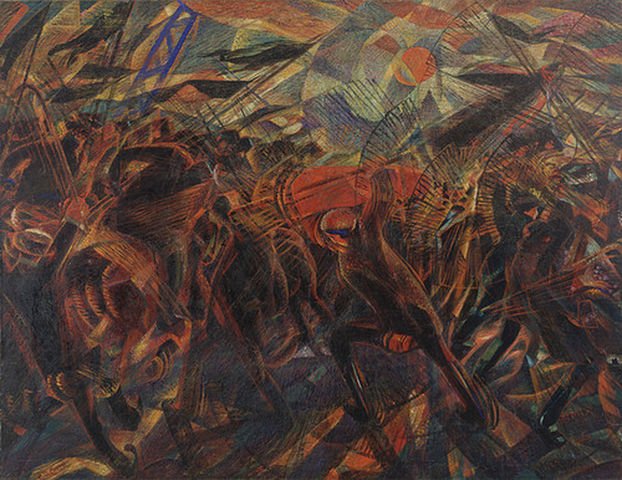ADSactly Literature: Futurism: the “First Incendiaries” (Part I)

Dear friends, in a last post I made an introduction and general presentation of that capital stage of aesthetic modernity known as avant-gardeism or artistic avant-garde movements. Now, I enter to consider the movement that initiates it: the Futurism.
As it is part of the "tradition of the rupture", it is heir and continuation of that impulse inaugurated by Romanticism, of which Parnasianism, Symbolism and Impressionism were also before. But, as Octavio Paz points out
there is something that distinguishes avant-garde movements from previous ones: the violence of attitudes and programs, the radicalism of works. The avant-garde is an exasperation and an exaggeration of the tendencies that preceded it.
And this is the right foot to start dealing with Futurism.

The writer Philippe Soupault, in a short critical text on the avant-garde rebellion, takes up the image of pyromania to assess this attempt, and reaffirms that the Futurists were "the first arsonists". He states that they did not want to know the "meaning" of their rebellion, but that they understood that "the scandal was necessary". He adds: "It must be recognized, however, that they were the first to demand radical changes."
He inaugurates the era of the "isms" of the 20th century, as the Spanish writer Ramón Gómez de la Serna called them in 1943, marking the spirit that will characterise contemporary times with a desire for constant change of style.
But let's see some data of its emergence and development, as well as its representatives and characteristics.
On February 20, 1909, a text entitled "Manifesto of Futurism " appeared in the French newspaper Le Figaro (you can read it in the French facsimile version, in Italian, in English or in Spanish), signed by Filippo Tomaso Marinetti, an Italian writer born in Alexandria, Egypt, in 1879 and who died in Milan in 1944. Marinetti, whose literary life initially took place in Paris, had been closely linked to French symbolism and had been influenced by precursors of avant-garde literature such as Alfred Jarry. He was not the author of a major literary production; he published some novels, plays and poems. It is in his work Zang-Tumb-Tumb, from 1914, that the formal contributions considered important for the avant-garde literary advance appear, as we will indicate later.

Although its creator and representative par excellence was a writer, it was not literature that was most developed in Futurism, but the plastic arts. When the manifesto was read by its author publicly in a theatre in Turin, several Italian painters who occupy an important place in the development of these arts joined him, namely Humberto Boccioni, Carlo Carra and Luigi Russolo. Accompanying these, although at a distance, and coming from an earlier influence (Neo-Impressionism), are Giacomo Balla and Gino Severini.
Among the values of Futurism there is an irrational reaction against the past and tradition, which is expressed as a denial of the historical, the overvaluation of the future and the preponderance of the present ("actualism", some critics call it), and a certain iconoclasm.
It also highlights his exacerbated aesthetic appreciation of matter and the machine (machinism), as well as the exaltation of the national and patriotic, which together with paroxysm and the violent and warlike impulse, make him a precursor of the nascent fascism. Although its leader died in the 1940s, futurism died out at the end of the First World War.
It became known through several manifestos (about 30), which became his real work, as Guillermo de Torre says. Let's see some fragments of the first manifesto.
I. We want to sing the love of danger, force and recklessness.
II. The capital elements of our poetry will be courage, audacity and rebellion.
III. In contrast to literature which has magnified up to now the immobility of thought,
the ecstasy and the sleep, we're going to glorify the aggressive movement, the insomnia
feverish, the gymnastic step, the risky jump, the slaps and the punch.
IV. We declare that the splendor of the world has been enriched by a new beauty: the beauty
of speed. A racing car with its belly adorned with thick pipes, similar
to snakes with explosive and angry breath... a car that seems to run on shrapnel, is
more beautiful than the Victory of Samothrace.
(…)
Continue in next post.
Bibliographical references:
Compagnon, Antoine (1993). The five paradoxes of modernity. Venezuela: Monte Ávila Editores.
Friedrich, Hugo (1974). Structure of modern lyrics. Spain. Edit. Seix Barral.
Paz, Octavio (1985). The sons of the slime. Colombia: Edit. La Oveja Negra.
Pierre, José (1968). Futurism and Dadaism (Introduction by Philippe Soupault). Spain: Edit. Aguilar.
Raymond, Marcel (1983). From Baudelaire to Surrealism. Spain: Fondo de Cultura Económica.
Torre, Guillermo de (1974). History of avant-garde literatures (Volume I). Spain: Edit. Guadarrama.
Written by @josemalavem
Click the coin below to join our Discord Server
)
This Italian movement, like most artistic movements: it sought to invent a new concept of life, of beauty, but in this case linked to the concept of the machine, of speed. To leave art behind and renew the look is a precept that many have sought, but few have achieved. I feel that futurism managed to make this renewal visible to a certain extent and that it remained on a visual scale, without much depth. In particular, I like painting and photography with a futuristic influence. An interesting new beginning, @josemalavem.